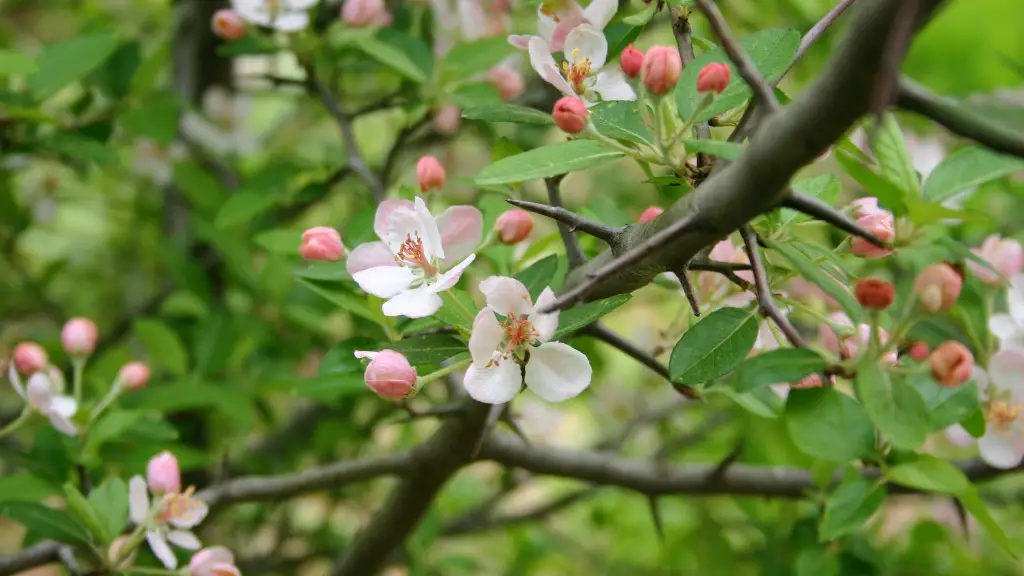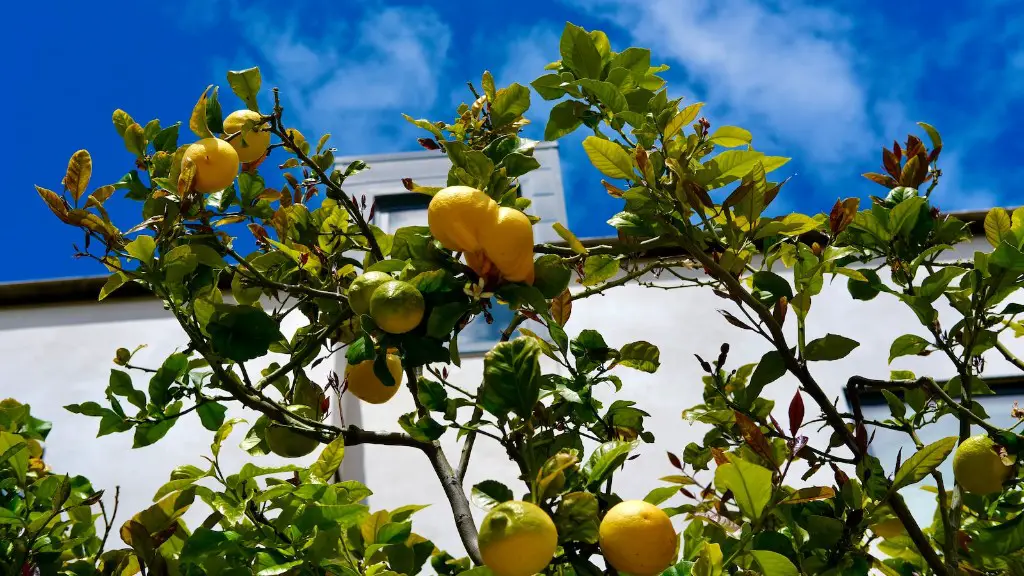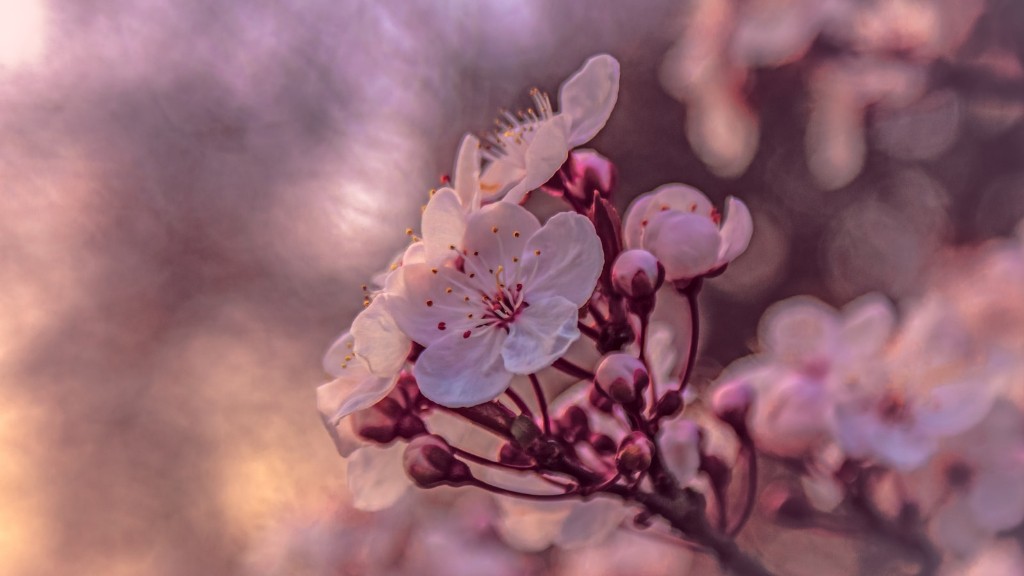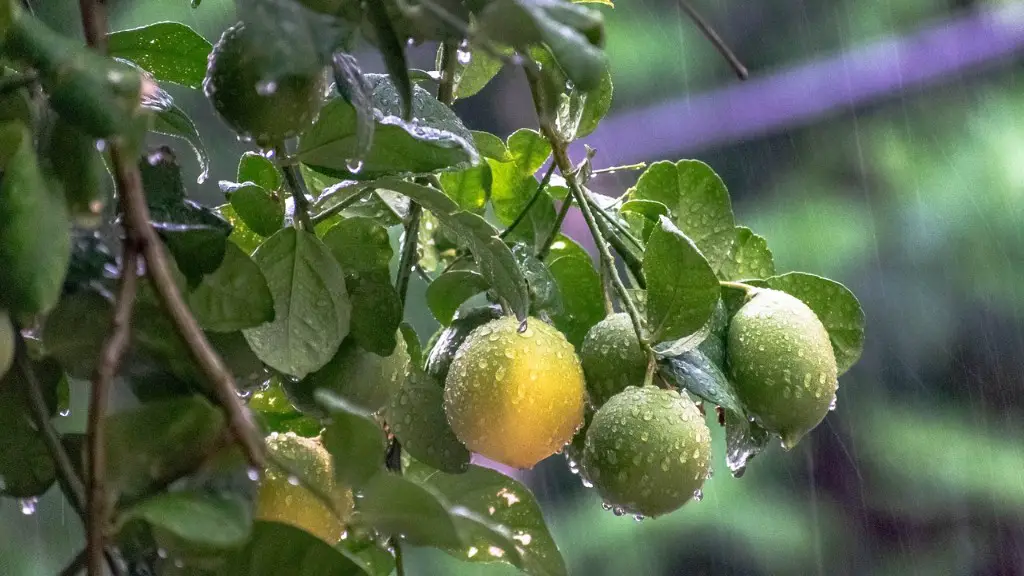A Honeycrisp apple tree is an iconic sight across the United States. Its crisp, juicy, and downright delicious fruit makes it very popular with humans, as well as wildlife. The tree itself is easily recognizable, with its vigorous upright form and deep green foliage.
The average Honeycrisp tree reaches up to 25 feet in height with a spread of 18-20 feet. It’s quite a sight to behold when mature and in full bloom, with abundant pink and white flowers blanketing the canopy. Its branching structure and deep green leaves give it a distinctly symmetrical appearance.
The bark of the Honeycrisp apple tree is smooth and can be a pale gray, yellowish-gray, or even reddish-brown. It’s easy to spot, and often has faint horizontal stripes across its trunk. As the tree matures, these stripes become less pronounced and the overall colors become more uniform.
A Honeycrisp apple tree prefers full or partial sun and does best in well-drained soil with a neutral pH. It should be planted in an area with considerable air circulation for the best fruit production. It’s also important to keep the roots of the tree in moist soil and make sure to water it regularly.
The best time to prune a Honeycrisp apple tree is late winter or early spring, before new growth begins. Pruning allows for better air circulation and light penetration through the canopy which helps promote healthy fruit production. It’s best to remove any branches that are overcrowded or interfere with one another, as well as any dead or diseased branches.
It’s important to choose a Honeycrisp apple tree that is certified disease-resistant and true to type. The characteristics that make a Honeycrisp apple tree so delicious are the result of extensive selection, so it’s best to choose one that has been properly certified.
With proper care, a Honeycrisp apple tree can provide years of delicious fruit and breathtaking beauty. Its signature gnarled branches are a delight to behold and its sweet, crisp fruit brings immense pleasure. They truly are a remarkable tree that any gardener would be lucky to have.
Types of Honeycrisp Apples
The Honeycrisp apple tree is a unique and remarkable fruit tree, prized for its crisp, sweet apples. It was initially developed in Minnesota in the 1960’s and its popularity has spread steadily ever since. There are several varieties of Honeycrisp apples, each one having its own unique characteristics.
The original Honeycrisp apple is larger than average and can be identified by its distinctive brown-red skin. It is known for its sweet flavor and crisp texture and is one of the sweetest varieties of apple available. The Keepsake apple is a newer variety of Honeycrisp and is a bit smaller and sweeter than the original. It also has a brighter orange-red color than the original.
The Coralstar apple is a cross between Honeycrisp and another apple variety. Its characteristic greenish-yellow skin makes it easily identifiable and it is known for its juicy sweetness and tart flavor. Finally, the Zestar apple is a cross between Honeycrisp and another variety and is characterized by its bright yellow-green skin. It is crisp yet sweet and is a great addition to the lineup of Honeycrisp apples.
Honeycrisp apples are a special treat and have their own unique characteristics. The different varieties offer something for everyone, from sweet and crisp to juicy and tart. They make an excellent addition to any harvest and any diner’s plate.
Nutritional Benefits of Honeycrisp Apples
Honeycrisp apples are a naturally healthy and delicious treat. They are low in calories and high in dietary fiber, making them a great snack for weight management. Additionally, they are chock-full of important vitamins and minerals such as Vitamin C, riboflavin, folate, and potassium.
Honeycrisp apples provide a variety of important antioxidants and polyphenols. Antioxidants help reduce oxidative stress in the body and polyphenols contain antiviral and anti-inflammatory properties. Furthermore, they are rich in dietary fiber, which is important for proper digestion and regularity.
The phytonutrients in Honeycrisp apples provide anti-cancer benefits and may improve heart health. Additionally, their beta-carotene content is thought to protect against certain diseases such as macular degeneration and age-related vision loss. For those looking for a healthier choice of snack, Honeycrisp apples are a great way to go.
Thanks to their combination of vitamins, minerals, antioxidants, and phytonutrients, Honeycrisp apples provide a wealth of nutritional benefits. They make a great snack, as well as a delicious addition to all sorts of dishes, from salads to desserts. With Honeycrisp apples, good health and great taste come together in perfect harmony.
Growing & Harvesting Honeycrisp Apples
Growing Honeycrisp apples is a satisfying experience. Not only do you get to enjoy the sight of a mature and flowering tree, you get to savor the flavor of their fresh fruit, too. As with any fruit tree, there are a few things to consider when planting and growing a Honeycrisp.
Honeycrisp apple trees need plenty of space and should not be planted too close together. They need full or partial sun and plenty of air circulation. Additionally, it’s important to choose a variety that is certified disease-resistant and true to type.
The best time to plant a Honeycrisp apple tree is in the late winter or early spring. It’s important to provide regular water and to keep the roots in moist soil. Furthermore, regular pruning is essential to promote proper air circulation and healthy fruit production.
Harvesting Honeycrisp apples can commence late summer, with the peak harvest time occurring late September – early October. It’s important to pick them when they are ripe, as unripe apples will not continue to ripen off the tree. And, once picked, they should be consumed soon, as Honeycrisp apples have a relatively short shelf-life.
Growing and harvesting Honeycrisp apples is a rewarding experience. There’s nothing quite like the taste of a freshlypicked Honeycrisp apple, and the sight of a mature and flowering tree is a delight in itself. It’s a joy to behold and a pleasure to savor.
Cooking & Baking With Honeycrisp Apples
Honeycrisp apples are a versatile and delicious ingredient. They can be eaten raw or cooked, and make a wonderful addition to all sorts of dishes. Salads, smoothies, baked goods, and desserts, all can benefit from the addition of Honeycrisp apples.
Their crunchy texture and sweet-tart flavor are the perfect combination for pies, muffins, and breads. They also make a delicious addition to oatmeal and porridge. They can also be diced and added to cobblers and crisps for a unique and flavorful surprise.
Honeycrisp apples are a great source of natural sweetness and can be used to replace sugar in certain recipes. They also make a great snack. With so many ways to use them and their natural sweetness, Honeycrisp apples are a perfect addition to any pantry.
Cooking and baking with Honeycrisp apples is a pleasure. They have vast culinary potential and make a wonderful addition to all sorts of dishes. But, beyond the delicious dishes they inspire, they can also give us a feeling of warmth and comfort. And, that’s something we can all appreciate.
Honeycrisp Apples: A Decade of Deliciousness
Honeycrisp apples have been around for over 10 years, yet they still reign as the king of apples. And, it’s no wonder why. They are crisp, juicy, and sweet, and their popularity continues to grow each year.
It’s incredible to think of the impact these apples have had on the apple-growing industry. From its development in the 1960’s to its current status as a well-known and widely consumed apple, Honeycrisp apples have been a game-changer for many growers.
Their unique qualities are what sets them apart from other apples. From their crunchy texture to their sweet-tart flavor, Honeycrisp apples make a distinct impression. Whether enjoyed raw or cooked, there’s nothing quite like the taste of a Honeycrisp apple.
Honeycrisp apples have been around for more than a decade and their popularity is still going strong. It’s easy to see why they are so beloved, as they are a sweet, crunchy, and downright delicious apple. They truly are a remarkable fruit that continues to delight and tantalize the taste buds.




